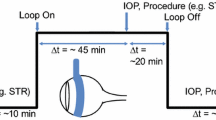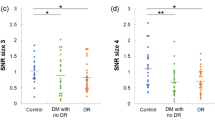Abstract
Spontaneously diabetic Torii (SDT) rats are an inbred strain of rats with a non-obese type 2 diabetes mellitus that were isolated from an outbred colony of Sprague–Dawley (SD) rats. Electroretinograms (ERGs) were recorded from SDT and SD (controls) rats at 10- and 44-weeks-of-age to determine their retinal function. The amplitudes and implicit times of the ERGs of the right and left eyes were not significantly different indicating that the intra-individual variation was small. Both amplitudes and implicit times of the ERGs in the SDT rats were not significantly different from those of SD rats at 10-weeks-of-age. At 44-weeks-of-age, however, the a- and b-waves and the oscillatory potentials were significantly reduced with prolonged implicit times in the SDT rats compared to SD rats. These depressed ERGs may reflect vascular and neuronal damage throughout the retina as are seen in the advanced stages of human diabetic retinopathy. Thus, the SDT rat can be used to study the retinal physiology of diabetic retinopathy.



Similar content being viewed by others
References
Moss SE, Klein R, Klein BE (1998) The 14-year incidence of visual loss in a diabetic population. Ophthalmology 105:998–1003
Aiello LP, Gardner TW, King GL et al (1998) Diabetic retinopathy. Diabetes Care 21:143–156
Yonemura D (1962) The oscillatory potential of the electroretinogram. Nippon Ganka Gakkai Zasshi 66:1566–1584
Satoh S, Iijima H, Imai M et al (1994) Photopic electroretinogram implicit time in diabetic retinopathy. Jpn J Ophthalmol 38:178–184
Sakai H, Tani Y, Shirasawa E et al (1995) Development of electro-retinographic alterations in streptozotocin-induced diabetes in rats. Ophthalmic Res 27:57–63
Kojima K, Matsubara H, Harada T et al (1985) Effects of aldose reductase inhibitor on retinal microangiopathy in streptozotocin-diabetic rats. Jpn J Ophthalmol 29:99–109
Bursell SE, Clermont AC, Shiba T et al (1992) Evaluating retinal circulation using video fluorescein angiography in control and diabetic rats. Curr Eye Res 11:287–295
Hancock HA, Kraft TW (2004) Oscillatory potential analysis and ERGs of normal and diabetic rats. Invest Ophthalmol Vis Sci 45:1002–1008
Chung NH, Kim SH, Kwak MS (1993) The electroretinogram sensitivity in patients with diabetes. Korean J Ophthalmol 7:43–47
Shinohara M, Masuyama T, Shoda T et al (2000) A new spontaneously diabetic non-obese Torii rat strain with severe ocular complications. Int J Exp Diabetes Res 1:89–100
Masuyama T, Fuse M, Yokoi N et al (2003) Genetic analysis for diabetes in a new rat model of nonobese type 2 diabetes, Spontaneously Diabetic Torii rat. Biochem Biophys Res Commun 304:196–206
Yamada H, Yamada E, Higuchi A et al (2005) Retinal neovascularisation without ischaemia in the spontaneously diabetic Torii rat. Diabetologia 48:1663–1668
Miao G, Ito T, Uchikoshi F et al (2004) Stage-dependent effect of pancreatic transplantation on diabetic ocular complications in the spontaneously diabetic Torii rat. Transplantation 77:658–663
Sasase T, Ohta T, Ogawa N et al (2006) Preventive effects of glycaemic control on ocular complications of Spontaneously Diabetic Torii rat. Diabetes Obes Metab 8:501–507
Behn D, Doke A, Racine J et al (2003) Dark adaptation is faster in pigmented than albino rats. Doc Ophthalmol 106:153–159
Bloodworth JM Jr (1962) Diabetic retinopathy. Diabetes 11:1–22
Author information
Authors and Affiliations
Corresponding author
Rights and permissions
About this article
Cite this article
Okuno, T., Oku, H., Sugiyama, T. et al. Electroretinographic study of spontaneously diabetic Torii rats. Doc Ophthalmol 117, 191–196 (2008). https://doi.org/10.1007/s10633-008-9122-0
Received:
Accepted:
Published:
Issue Date:
DOI: https://doi.org/10.1007/s10633-008-9122-0




